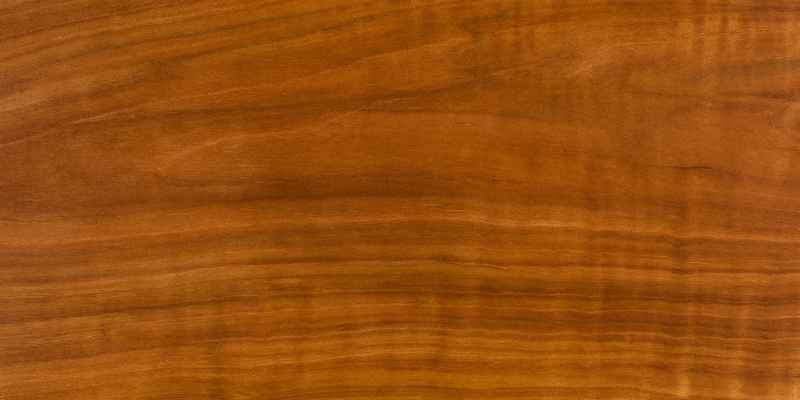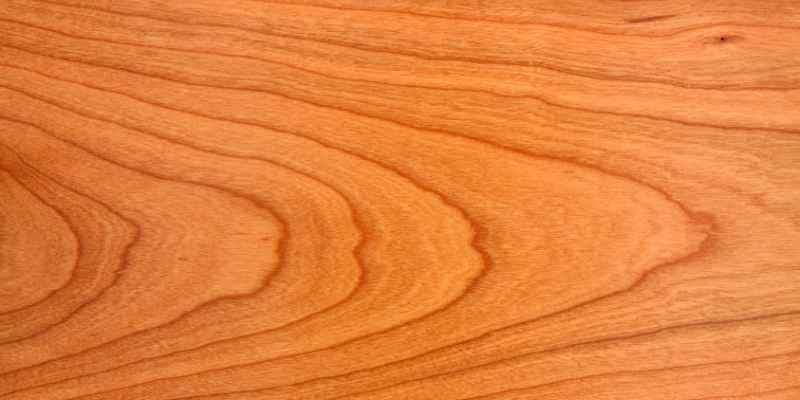To identify cherry wood, note the initial nearly white sapwood and pinkish-brown heartwood of freshly cut American cherry. Over time and sun exposure, it darkens to a trademark reddish-brown appearance.
Cherry wood is cherished for its medium density, excellent bending properties, and ease of staining and finishing for furniture and joinery applications. The wood transitions from a light pink to rich reddish-brown color over time, creating a distinctive and elegant look.
With a straight-grain and smooth texture, cherry wood may contain brown pith flecks and small gum pockets, adding to its unique aesthetic appeal.
Characteristics Of Cherry Wood
Cherry wood is easily recognizable by its nearly white sapwood and pinkish-brown heartwood, which darkens to a reddish-brown shade when exposed to sunlight. It has medium density with good bending properties, making it highly valued for furniture and interior joinery due to its easy finishing and staining properties.
Natural Color Variation
Cherry wood starts as white sapwood and transitions to reddish-brown heartwood when exposed to light.
Texture And Grain Patterns
Cherry wood features a fine, even texture and straight grain, with occasional waves for added character.
Distinctive Scent Of Cherry Wood
The distinctive scent of cherry wood is mildly sweet and reminiscent of cherries, adding a pleasant aroma to spaces.
Identifying Cherry Wood
Cherry wood is a popular choice for furniture and interior joinery due to its beautiful reddish-brown hue and versatility. Knowing how to identify cherry wood is essential for woodworking and furniture enthusiasts. Here, we will discuss various methods to help you identify this prized hardwood.
Visual Inspection
One of the first steps in identifying cherry wood is through visual inspection. Freshly cut cherry wood has a distinctive nearly white sapwood and a darker, pinkish-brown heartwood. Over time and with exposure to sunlight, the color transitions to cherry wood’s classic reddish-brown appearance.
Smell Test
Another way to identify cherry wood is through its unique aroma. The scent of cherry wood is sweet and fragrant, distinct from other types of wood. A characteristic, pleasant smell is a good indicator of the presence of cherry wood.
Testing Wood Density
Cherry wood has medium density and offers good bending properties, medium strength, and shock resistance. It is important to test the density of the wood by feeling its weight and texture. Medium density, along with its characteristic reddish-brown appearance, further confirms the presence of cherry wood.
Differences Between Cherry And Similar Woods
When it comes to identifying cherry wood, it is important to understand the key differences between cherry and similar woods such as maple, mahogany, and walnut. While all of these woods have their own unique characteristics, being able to recognize the distinct features of cherry wood will help you make an accurate identification. Let’s take a closer look at the differences between cherry and each of these woods:
Cherry Vs. Maple
Cherry wood and maple wood may appear similar at first glance, but there are distinct differences between the two. One of the key differences is in their color. While cherry wood has a trademark reddish-brown appearance that darkens over time, maple wood has a lighter, cream-colored hue. Additionally, cherry wood has a more pronounced grain pattern with subtle waves and occasional knots, whereas maple wood has a more uniform and consistent grain pattern.
Cherry Vs. Mahogany
Another wood commonly mistaken for cherry wood is mahogany. However, there are several ways to differentiate between the two. One noticeable difference is in their color. Mahogany wood generally has a rich, deep reddish-brown color with darker streaks, while cherry wood has a lighter reddish-brown hue. Another distinguishing characteristic is in the grain pattern. Cherry wood typically has a straight and subtle grain, while mahogany wood has a more interlocking and prominent grain pattern.
Cherry Vs. Walnut
Cherry wood and walnut wood are both highly valued for their beauty and rich tones, but they have distinct differences. One primary difference is in their color. Cherry wood has that signature reddish-brown hue, while walnut wood has a darker, chocolate brown color with occasional purple or reddish undertones. Grain patterns also differ between the two. Cherry wood typically has a smooth and consistent grain, while walnut wood has a more pronounced and intricate grain with swirling patterns.
In conclusion, being able to identify cherry wood involves understanding its unique characteristics and differentiating it from similar woods like maple, mahogany, and walnut. By paying attention to details such as color, grain patterns, and overall appearance, you can confidently identify cherry wood and appreciate its distinct beauty in furniture and interior joinery.
Applications Of Cherry Wood

Furniture Making
Cherry wood, with its reddish-brown hues, is a popular choice for crafting high-quality furniture pieces.
Interior Joinery
Interior joinery projects benefit from the medium density and excellent finishing properties of cherry wood.
Common Uses In Construction
Cherry wood is often utilized in construction for its stability, bending properties, and attractive appearance.
Maintaining Cherry Wood
Staining And Finishing Techniques
When finishing cherry wood, it is important to use a stain with care and precision. Due to its structure, cherry wood can absorb finishes unevenly, resulting in blotchy or streaky appearances. Therefore, a pre-stain conditioner should be used to ensure an even application of stain. After applying the stain, a clear protective finish, such as varnish or lacquer, should be added to preserve the color and protect the wood from damage.
Preventing Common Damage
To prevent common damage to cherry wood, it is crucial to avoid exposing it to direct sunlight for prolonged periods. Sunlight can cause the color of the wood to darken and possibly fade over time. Additionally, using coasters or placemats under items such as glasses or plates can prevent water rings or marks. Furthermore, it is essential to avoid placing hot items directly onto the cherry wood surface, as heat can cause discoloration or even burns.
Proper Cleaning Methods
When cleaning cherry wood, it is important to use a soft, damp cloth to gently remove dust and dirt. Harsh or abrasive cleaning materials should be avoided, as they can damage the wood’s surface. Regular dusting can help maintain the wood’s luster and prevent the build-up of grime. Moreover, occasional polishing with a high-quality wood polish can restore the natural shine of the cherry wood.

Caring For Cherry Firewood
Cherry firewood is a popular choice for its pleasant aroma and efficient burning properties. To ensure optimal performance and longevity, proper care and maintenance are essential for cherry firewood. Below are key guidelines on how to identify, burn, season, and store cherry firewood.
Identifying Cherry Firewood
Identifying cherry firewood is crucial for both safety and efficiency. American cherry wood features a white sapwood and pinkish-brown heartwood that darkens to a reddish-brown hue when exposed to sunlight.
Burning Characteristics
Cherry firewood offers medium density with good bending properties, making it ideal for furniture and interior joinery. It burns efficiently, providing a pleasant aroma and steady heat output.
Seasoning And Storage Tips
Proper seasoning is key to maximizing the burning efficiency of cherry firewood. Ensure the wood is seasoned for at least 6-12 months in a well-ventilated area to reduce moisture content. Store the seasoned wood in a dry location off the ground to prevent it from absorbing moisture.
Frequently Asked Questions Of How To Identify Cherry Wood
How Can You Tell If It’s Cherry Wood?
Cherry wood has a white sapwood and pinkish-brown heartwood. Exposed to sunlight, it darkens to a reddish-brown color. It can change from light pink to light pinkish-brown or deeper red tones when aged. Cherry wood is known for its rich color and is used for furniture and interior joinery.
How Do You Identify Cherry Tree Wood?
Cherry wood can be identified by its white sapwood and darker, pinkish-brown heartwood. Over time, the color of cherry wood darkens and develops a reddish-brown appearance. It has a straight-grain, smooth texture, and may contain brown pith flecks and small gum pockets.
What Are 3 Characteristics For Cherry Wood?
American cherry wood has a nearly white sapwood and pinkish-brown heartwood. When exposed to sunlight, it darkens to reddish-brown. It has medium density, good bending properties, and easy staining. The wood starts as light pink, ripening to rich reddish brown over time.
What Does Cherry Wood Look Like Naturally?
Cherry wood naturally starts as light pink, aging to rich reddish-brown with sunlight exposure.
Conclusion
Identifying cherry wood can be an enriching experience that involves understanding its unique coloring and texture. With its light pink hue maturing into a rich reddish-brown over time, cherry wood is highly valued for its versatility and aesthetic appeal in furniture and interior joinery.
Embracing the organic transformation of cherry wood allows for a deeper appreciation of its natural beauty and charm.


